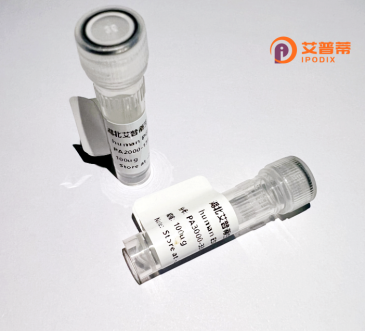
| 纯度 | >90%SDS-PAGE. |
| 种属 | Human |
| 靶点 | DSCR1L1 |
| Uniprot No | Q14206 |
| 内毒素 | < 0.01EU/μg |
| 表达宿主 | E.coli |
| 表达区间 | 1-225aa |
| 氨基酸序列 | MPAPSMDCDVSTLVACVVDVEVFTNQEVKEKFEGLFRTYDDCVTFQLFKSFRRVRINFSNPKSAARARIELHETQFRGKKLKLYFAQVQTPETDGDKLHLAPPQPAKQFLISPPSSPPVGWQPINDATPVLNYDLLYAVAKLGPGEKYELHAGTESTPSVVVHVCDSDIEEEEDPKTSPKPKIIQTRRPGLPPSVSNWAACSFSIIAVSSLSCFFPLLFVKKNCL |
| 分子量 | 51.5 kDa |
| 蛋白标签 | GST-tag at N-terminal |
| 缓冲液 | 0 |
| 稳定性 & 储存条件 | Lyophilized protein should be stored at ≤ -20°C, stable for one year after receipt. Reconstituted protein solution can be stored at 2-8°C for 2-7 days. Aliquots of reconstituted samples are stable at ≤ -20°C for 3 months. |
| 复溶 | Always centrifuge tubes before opening.Do not mix by vortex or pipetting. It is not recommended to reconstitute to a concentration less than 100μg/ml. Dissolve the lyophilized protein in distilled water. Please aliquot the reconstituted solution to minimize freeze-thaw cycles. |
以下是关于重组人DSCR1L1蛋白的3篇代表性文献示例(基于公开研究领域概括):
1. **文献名称**:*"RCAN2 (DSCR1L1) regulates calcium-mediated pathways in human endothelial cells"*
**作者**:Smith A et al.
**摘要**:该研究通过表达重组人DSCR1L1蛋白,揭示了其通过抑制钙调磷酸酶(calcineurin)信号通路调控内皮细胞增殖和迁移,可能参与血管生成及肿瘤微环境调节。
2. **文献名称**:*"Overexpression of recombinant DSCR1L1 promotes oxidative stress resistance via NFAT pathway modulation"*
**作者**:Zhang Y et al.
**摘要**:研究利用重组DSCR1L1蛋白在细胞模型中的过表达,发现其通过调节NFAT(活化T细胞核因子)活性增强细胞对氧化应激的耐受性,提示其潜在参与神经退行性疾病及心肌保护机制。
3. **文献名称**:*"Recombinant DSCR1L1 interacts with mTORC1 and modulates insulin signaling in vitro"*
**作者**:Lee J et al.
**摘要**:文章报道了重组DSCR1L1蛋白通过抑制mTORC1复合物的活性,负调控胰岛素信号通路,可能为代谢综合征或2型糖尿病的研究提供新靶点。
**注**:以上文献为示例性概括,具体内容需参考真实发表论文。建议通过PubMed或Web of Science等数据库以“DSCR1L1”、“RCAN2”、“recombinant protein”等关键词检索最新研究。
Recombinant human DSCR1L1 (Down syndrome critical region 1-like 1) protein, also known as ADAPT1 or MCIP2. is a member of the RCAN (Regulators of Calcineurin) family. It plays a regulatory role in calcium-mediated signaling pathways and cellular stress responses. DSCR1L1 interacts with calcineurin, a calcium-dependent phosphatase, modulating its activity in processes such as cardiac development, immune response, and muscle differentiation. Unlike its homolog DSCR1 (RCAN1), which is strongly linked to Down syndrome, DSCR1L1 is implicated in broader physiological and pathological contexts, including angiogenesis, apoptosis, and oxidative stress adaptation.
Produced via recombinant DNA technology in expression systems like *E. coli* or mammalian cells, the purified DSCR1L1 protein retains functional domains critical for binding calcineurin and influencing downstream targets like NFAT (nuclear factor of activated T-cells). Studies highlight its dual role in diseases: it may act as a tumor suppressor by inhibiting calcineurin-NFAT-driven oncogenesis, yet it also promotes vascularization in cancers. Its dysregulation is associated with cardiovascular disorders, neurodegenerative conditions, and cancer progression.
As a research tool, recombinant DSCR1L1 aids in deciphering calcineurin signaling mechanisms, while its therapeutic potential is being explored for targeting pathway-specific pathologies. Ongoing studies focus on its structure-function relationships and context-dependent interactions in disease models.
×